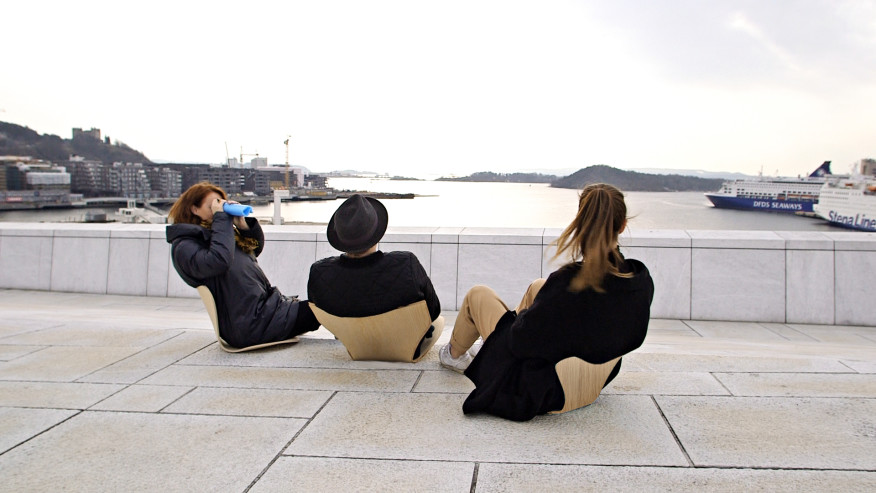Snøhetta revises the Series 7 chair
How to interpret the Series 7 by Arne Jacobsen? For the iconic chair’s 60th anniversary, Fritz Hansen invited international architects to think about new renditions of it. One of the most striking ideas has come from Oslo-based architecture and design office Snøhetta. In this conversation, senior interior architect Marlene Fenger Vedal, architect Stian Alessandro Ekkernes Rossi, and graphic designer Sofie Platou from the practice’s multidisciplinary team, explain how their idea of a shell without legs came to be, and what added value is brought by this rocking version that also spins sideways.
DAMnº Why was it interesting for you to interpret the Series 7 chair?
Marlene Fenger Vedal: Arne Jacobsen is such an important architect and designer for Scandinavia and the rest of the world. His Series 7 chair is an icon. For us, it is a challenge to look at a previously designed object and discuss whether we can add something or change its use. We were not interested in creating our own icon or a new chair – we wanted to find out if we could bring new value to the existing design.
DAMnº Is the effect of iconic furniture pieces similar to that of architectural icons?
MFV: Both are everlasting. Even if they are specifically of their era, they continue to stand strong over time. Good design is never out-dated, it is timeless. Sofie Platou: There are many icons in different fields, and they all have something in common: people take these objects to heart. The status of the Series 7 also has a lot to do with Arne Jacobsen’s design approach. He wanted to make a low-cost chair that could be produced in large quantities.
DAMnº How did you approach the project?
Sofie Platou: Fritz Hansen delivered two raw shells of the chair to our office in Oslo. When we began our research, we played around with these. All of a sudden, we were sitting in the shell without its legs, rocking around on the floor. We were intrigued to see how it worked in this way, without legs.
DAMnº What else came with that initial idea?
Stian Alessandro Ekkernes Rossi: Actually, we connected the idea of the shell-without-legs to one of our architectural projects, the Rauland Mountain Church in Norway. The concept for the building was to bring the church to the people. Thus, we placed it in the middle of a ski area up in the mountains. Skiers can use the space as a common room and can ski into it from the slopes. The design of the church is free, as the building is taken out of the formal urban context. That is exactly what we did with the chair – we separated the shell from the legs, which are responsible for the formal aspect, and came to a freer and softer version. Our intention was a seat for use in a more social setting, be it indoor or outdoor. In the Mountain Church, for example, you can easily take all the chairs outside for an outdoor service. Or you can use the shell for a concert on the rooftop of the Oslo Opera House – with a view to the sea.
SP: We also figured out how to attach straps so that the shell can be carried like a backpack and taken to the park or to the beach – moving your living room outdoors! Another option is that the shell can be attached to its legs for use indoors, and can be detached for carrying outside. The shell offers a very relaxing way of sitting, like a rocking chair that also spins sideways.
DAMnº What about the matter of one’s balance when sitting in the shell?
MFV: We have added a rubber element on the back, in the curved part. It gives the user balance and stops the shell at both of the angles, so that the person won’t fall over.
DAMnº The landscape is an important consideration in many of Snøhetta’s architectural projects. Is that also the reason you thought about an outdoor possibility?
MFV: Absolutely. We always try to integrate the landscape and the environment into our projects, so this was also a natural outcome of our interpreting the chair. We wanted to make it more playful and social, and to encourage people to use it both indoors and out in nature.
Text: Sandra Hofmeister
Photo: Snøhetta

